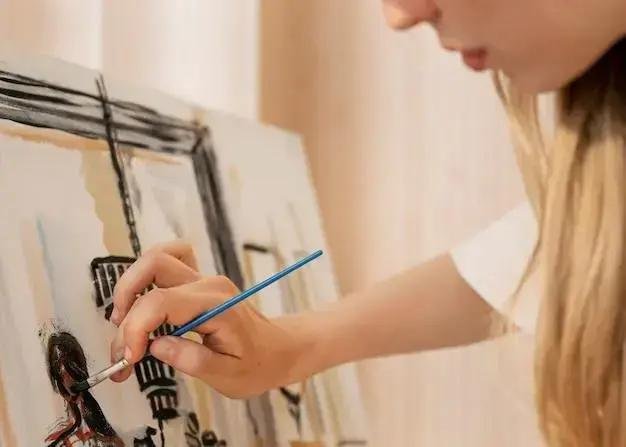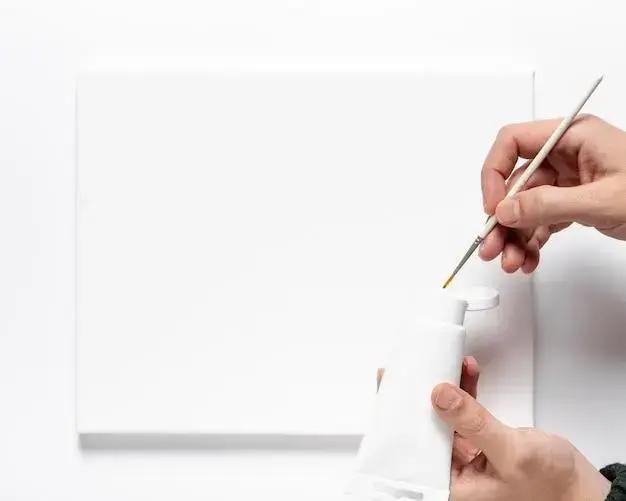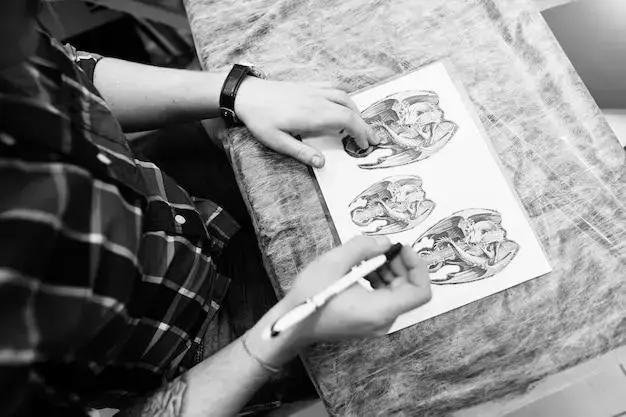If you’ve ever wanted to capture the beauty of a photo in your own sketches, you’re in the right place!
Learning how to sketch from photos can open up a world of creativity and help you improve your artistic skills.
In this guide, we’ll break down the process into five simple steps that will have you sketching like a pro in no time.
Get ready to unleash your inner artist!
Choosing the Right Photo
Choosing the right photo is crucial when you want to sketch from photos. The photo should inspire you and provide clear details for your sketch. Here are some tips to help you pick the perfect image:
- Focus on Composition: Look for photos with strong compositions. This means they should have a clear subject and interesting elements that draw the viewer’s eye. Photos with good lighting and contrast often work best.
- Avoid Overly Complex Images: While it might be tempting to choose a detailed landscape or a busy street scene, starting with simpler images can make the sketching process easier. Look for photos with fewer elements to help you focus on the basics.
- Consider the Lighting: Good lighting can enhance the depth and dimension of your sketch. Photos taken during the golden hour (just after sunrise or before sunset) often have beautiful, soft lighting that can add warmth to your sketch.
- Use Reference Photos: If you’re sketching a person or an object, consider using a reference photo that captures the subject from multiple angles. This can help you understand the form and proportions better.
- Personal Connection: Choose a photo that resonates with you personally. Whether it’s a cherished memory or a stunning landscape you’ve visited, a personal connection can make the sketching process more enjoyable and meaningful.
By taking the time to choose the right photo, you’ll set yourself up for a successful and rewarding sketching experience. Remember, the goal is to enjoy the process and express your creativity!
Gathering Your Sketching Materials
Before you dive into sketching, it’s essential to gather your sketching materials. Having the right tools at your fingertips can make a significant difference in your experience and the quality of your work. Here’s a quick rundown of what you’ll need:
- Sketchbook: Choose a sketchbook that suits your style. For pencil sketches, a medium-weight paper (around 80-100 gsm) works well. If you plan to use ink or watercolors, consider a heavier paper that can handle wet media.
- Pencils: A range of pencils is ideal for sketching. Start with a hard pencil (like H or 2H) for fine lines and details, and a softer pencil (like B or 2B) for shading and darker lines. Having an eraser handy is also crucial for corrections!
- Charcoal or Pastels: If you want to add some flair to your sketches, consider using charcoal or pastels. They can create rich textures and bold lines that bring your drawings to life.
- Blending Tools: Blending stumps or tortillons are great for smoothing out pencil marks and creating soft shadows. A simple tissue or your finger can work too, but blending stumps provide more control.
- Ruler and Compass: While sketching is often about free expression, having a ruler and compass can help you draw straight lines and perfect circles, especially for more structured sketches.
Once you’ve gathered your materials, find a comfortable and well-lit space to work. This will help you focus and enjoy the process of bringing your photo to life through your sketches. Remember, the right tools can enhance your creativity and make sketching more enjoyable!
Breaking Down the Image into Shapes
Breaking down the image into shapes is a fundamental technique when learning how to sketch from photos. This approach simplifies the drawing process and allows you to capture the basic structure of your subject. Here’s how to effectively break down an image:
- Observe the Overall Structure: Start by looking at the photo as a whole. Try to identify the main shapes that make up the subject. For example, a human figure can be broken down into ovals for the head and torso, rectangles for the arms and legs, and circles for joints.
- Use Light Guidelines: Lightly sketch these basic shapes onto your paper. Don’t press too hard—these lines are just guides that you’ll refine later. This step helps you maintain proper proportions and placement as you progress.
- Focus on Proportions: Pay attention to the proportions between the shapes. For instance, if you’re sketching a face, notice how the eyes relate to the nose and mouth. Use your pencil to measure distances and angles to ensure everything looks balanced.
- Break Down Complex Areas: If you encounter a complex area, like a hand or a flower, break it down further into smaller shapes. For a hand, you might use rectangles for the palm and smaller ovals for the fingers. This makes it easier to draw each part accurately.
- Refine and Adjust: Once you have the basic shapes laid out, step back and assess your sketch. Make any necessary adjustments to the shapes, ensuring they align with the proportions and perspective of the original photo.
By breaking down the image into shapes, you’ll create a solid foundation for your sketch. This technique not only simplifies the process but also helps you build confidence in your drawing skills. Remember, every great sketch starts with a solid structure!
Adding Details and Textures
Once you have the basic shapes and structure of your sketch down, it’s time to focus on adding details and textures. This is where your drawing really starts to come to life! Here are some tips to enhance your sketch:
- Observe the Photo Closely: Take a moment to closely examine your reference photo. Look for specific details that make the subject unique, such as facial features, patterns in clothing, or textures in the background.
- Layering Techniques: Start adding details gradually. Use lighter pencil strokes for subtle textures and build up darker lines for more pronounced features. This layering technique creates depth and dimension in your sketch.
- Use Different Pencil Types: Switch between different pencil grades to achieve a variety of textures. Softer pencils (like 2B or 4B) are great for dark shadows and rich textures, while harder pencils (like H or 2H) can be used for finer details and lighter areas.
- Incorporate Cross-Hatching: Cross-hatching is a technique where you draw intersecting lines to create shadows and textures. Experiment with varying the density and direction of your lines to add depth to your sketch.
- Pay Attention to Light and Shadow: Observe how light interacts with your subject. Identify the light source in your photo and shade accordingly. Darker areas should be shaded more heavily, while lighter areas can remain more open to create contrast.
Adding details and textures is an essential step in transforming a simple outline into a dynamic and engaging sketch. Take your time with this process, and don’t be afraid to experiment with different techniques. The more you practice, the more your unique style will emerge!
Final Touches and Enhancements
After you’ve added details and textures to your sketch, it’s time for the final touches and enhancements. This step can elevate your artwork and give it that polished look. Here’s how to wrap up your sketch effectively:
- Review Your Sketch: Take a step back and look at your sketch from a distance. This helps you see any areas that may need more attention or adjustments. Are the proportions right? Do the shadows look natural? Make any necessary tweaks.
- Enhance Contrast: To make your sketch pop, consider enhancing the contrast. Darken the shadows and deepen the lines where necessary. This creates a more striking image and draws the viewer’s eye to key areas.
- Add Highlights: Using an eraser or a white pencil, add highlights to areas that catch the light. This could be the glint in an eye, the shine on a surface, or the reflection in water. Highlights can bring your sketch to life!
- Consider Background Elements: If your sketch feels a bit empty, think about adding background elements. This could be a simple wash of color, light shading, or even a few details that complement your main subject. Just be careful not to overpower the focal point.
- Sign Your Work: Don’t forget to sign your sketch! Adding your signature not only marks your ownership but also gives your artwork a finished, professional touch. You can place it discreetly in a corner or integrate it into the design.
Final touches and enhancements are what truly complete your sketch. Take your time with this process, and remember: art is subjective! Trust your instincts and enjoy the journey of bringing your vision to life. Celebrate your work, and keep sketching!
Conclusion
Learning how to sketch from photos is a rewarding journey that allows you to express your creativity and improve your artistic skills.
By choosing the right photo, gathering the right materials, breaking down the image into shapes, adding details and textures, and applying final touches, you can create stunning sketches that capture the essence of your subject.
Remember, practice makes perfect! The more you sketch, the more comfortable you’ll become with your techniques and style.
Don’t be afraid to experiment and make mistakes along the way—each sketch is a step toward becoming a better artist.
So grab your materials, find a photo that inspires you, and start sketching!
FAQ – Common Questions About Sketching from Photos
What type of photo is best for sketching?
Look for photos with strong compositions, good lighting, and fewer complex elements to make the sketching process easier.
What materials do I need to start sketching?
You’ll need a sketchbook, a range of pencils, blending tools, and possibly charcoal or pastels for added texture.
How can I break down an image into shapes?
Start by observing the overall structure and identifying basic shapes like ovals and rectangles. Lightly sketch these shapes to create a foundation.
What techniques can I use to add details to my sketch?
Use layering techniques, different pencil types, and cross-hatching to create depth and texture. Pay attention to light and shadow as well.
How do I know when my sketch is finished?
Review your sketch from a distance, enhance contrast and highlights, and add any necessary background elements. Don’t forget to sign your work!
Can I sketch from photos without any prior experience?
Absolutely! Sketching from photos is a great way to practice and improve your skills, regardless of your experience level.





